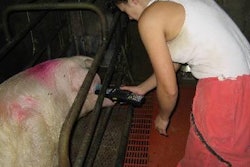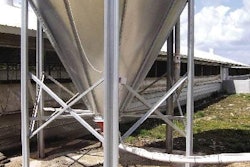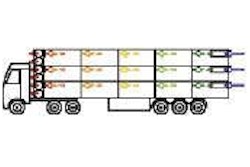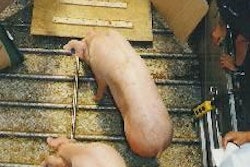
Last year while the European Union started its ban on the use of antibiotic growth promoters in pig feeds, Japan was introducing a risk evaluation system for antimicrobial agents and a positive list of the types permitted. These trends in both places have intensified the search for substances that might be used instead of antimicrobials for reasons other than the treatment of disease. Both western and oriental herbs and their extracts continue to be under examination. Recently in Japan, it has been reported that certain health benefits can be achieved for pigs by feeding them herbal mixtures in which plant-derived polysaccharides activate the macrophages of immunity defences in the body.
These reports brought reminders of early Japanese work on interferon as a therapeutic pharmaceutical product in human medicine. Now widely used by medical doctors in relation to viral diseases and cancers, in recent years it has also become used by veterinarians for treating animals infected with viruses.
One of the Japanese scientists who discovered interferon (IFN) in 1954 noted that its production in the body was promoted when some Chinese medicinal herbs were taken orally. It is now thought that the active ingredients in these IFN inducers' are polysaccharides, the compounds formed from simple sugars that include both starch and cellulose among their common examples. Plant polysaccharides are able to work like an antibiotic, but with a totally different mode of action from that of possible alternatives. Researchers working with the Chinese herbs today consider their improvements in health to be due not only to the action of components with obvious pharmacological effects, but also to a mechanism in which polysaccharide IFN inducers cause interferon to be produced in the body.
Several herbal species are able to lead to interferon production when consumed. A number of them are common foods in Japan, ranging from garlic (Allium sativum) and sesame seed (Sesamum indicum) to ginger (Zingiber officinale) and perilla (Perilla frutescens). Others are used as ingredients in pharmaceutical products, for example rhubarb (Rheum palmatum), angelica root (Angelica sinensis) and peony root (Paeonia lactiflora). Under Japanese law, however, plants incorporated in pharmaceuticals cannot be used as ingredients in health foods or veterinary feed. This applies to all forms of these plants, their extracts and even the waste materials following extraction as well as to unprocessed and processed whole-crop material.
We have assessed pig feeds containing non-pharmaceutical plant polysaccharides in our own work. Some 4-5 herbs were involved, selected from pumpkin seed (Cucurbita moschata), mugwort leaf (Artemisia vulgaris), chameleon plant leaf (Houttuynia cordata), Japanese honeysuckle flower (Lonicera japonica), plantain seed (Plantago asiatica), and safflower flower (Carthamus tinctorius). All these contain IFN inducers.
As a result of our investigations using these ingredients we compiled a list of the merits and demerits which we believe applied to the feed containing plant polysaccharides in our experience. This list is presented here as Table 1. Note a remark in the Table about the herbal compounds not being effective against diarrhoea. That was in fact added after a study that had focused specifically on pneumonia at a unit affected by PRRS. Our observations in that instance showed only a few piglets with diarrhoea and these were in the early stage of the study; there was no difference between the herbal-feed and control groups in this respect.
Each group consisted of 12 piglets, 30 days old and 5.8-9.5kg in bodyweight. Those receiving plant polysaccharides were given a 5-herb mixture in their feed at an inclusion rate of 0.2%. They gained significantly more weight per day once over 60 days old (Figure 1). At that stage they also were eating more feed daily. Over an observation period of 30 days afterwards, pigs in the control group had respiratory problems with pneumonia for a mean of 12.2 days. In the experimental group, the mean was 2.1 days a significant difference (Figure 2). Increases in PRRS antibody titre to a similar level in both groups indicated that the piglets were infected with the PRRS virus, but that those in the plant polysaccharides group had milder respiratory signs.
Separately, we have looked at 3 breeding-finishing herds (A = 140 sows, B = 100 sows, C = also 100 sows) in Japan where there were obvious respiratory troubles and high mortality rates in their grow-finish pigs. These farms are located in an area where there is a high incidence of respiratory disease, with pneumonia and mortality especially severe in winter. This time we used a feed containing 4 herbs when comparing 3263 weaned piglets in control groups with 3925 weaners in plant polysaccharides groups over a one-year period starting in mid-winter (Figure 3). The inclusion in the unit's normal feed was 0.1% in Herd A and 0.04% in Herds B and C. The plant polysaccharides were mixed and the piglets had continuous access to their feed supply.
Observations during the first 3 weeks after weaning confirmed that piglets in the plant polysaccharides group were significantly more vigorous and lively than the controls. Respiratory conditions started improving rapidly in Herd B and fewer pigs died, both then and later. In Herd C, feeding plant polysaccharides to the piglets stabilised their respiratory state, the effects becoming obvious on Week 3 and onwards in that the number of deaths declined.
The fact that the combinations of herbs in these 2 studies did not lower the incidence of diarrhoea was attributed to the use of plants lacking a direct antimicrobial action. Some previously unpublished data show that a different combination of plant polysaccharides decreases the number of pathogenic microbes that normally live in the intestines of pigs.
Another point of interest to us has been that after sows start receiving feed containing plant polysaccharides around the time of their transfer to a farrowing pen, the number of piglets born with an abnormality seems to decrease. Furthermore, we want to check on possible milk effects. Reports say that if feed containing plant polysaccharides are fed to dairy cows with mastitis, macrophages in the blood are activated, phagocytosis increases and the number of bacteria and somatic cells in the milk decrease. These findings suggest it may be possible to provide higher-quality milk to piglets by feeding polysaccharides to the sows during the lactation period.
In total, therefore, we contend that the practical use of these compounds in the future is worthy of attention, even if a perfect substitute for antimicrobial agents in feeds has not yet been established.

















